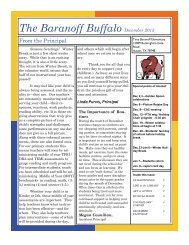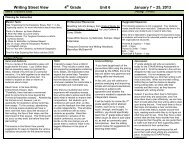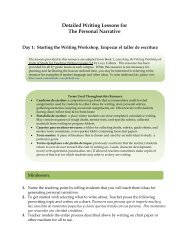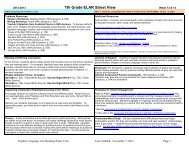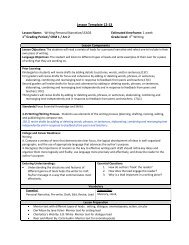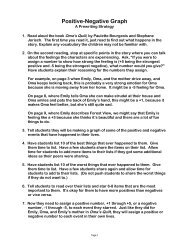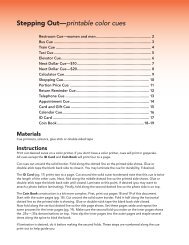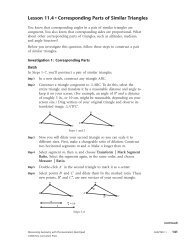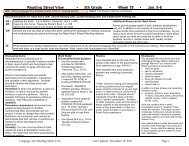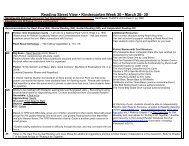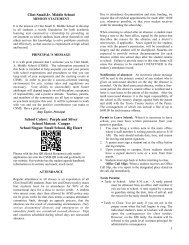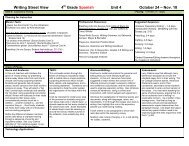Polygons and Their Angles
Polygons and Their Angles
Polygons and Their Angles
You also want an ePaper? Increase the reach of your titles
YUMPU automatically turns print PDFs into web optimized ePapers that Google loves.
Name: _________________________________<strong>Polygons</strong> <strong>and</strong> <strong>Their</strong> <strong>Angles</strong>Polygon Angle VocabularyThe sum of the measures of a pairof supplementary angles is 180˚.Two intersecting lines form twopairs of angles that are calledvertical angles. Vertical angles arenonadjacent <strong>and</strong> congruent.InteriorAngleExteriorAngleAn interior angle of a polygon isan angle in the interior of thepolygon formed by any twoconsecutive sides of the polygon.An exterior angle of a polygon isan angle formed by any side of apolygon <strong>and</strong> a line extended fromthe adjacent side.© Region 4 Education Service Center Supporting STAAR Achievement: GeometryAll rights reserved.
<strong>Polygons</strong> <strong>and</strong> <strong>Their</strong> <strong>Angles</strong><strong>Polygons</strong> are created by connecting line segments endpoint to endpoint. Below is a polygon createdby drawing five straight line segments.12431720 1819856716 1415 139 1012 111. What is the name of the polygon created?2. Are any angles in the drawing congruent? Which ones?3. Are any angles in the drawing supplementary? Which ones?4. Which angles are the interior angles of the polygon? Label the interior angles in the polygonabove with the letter I.5. Use your pencil to point to an exterior angle.Do you think everyone in your class will point to the same angle? Why?6. Using the definition on the previous page, which angles are exterior angles? Label the exteriorangles in the polygon above with the letter E.© Region 4 Education Service Center Supporting STAAR Achievement: GeometryAll rights reserved.
Name: _________________________________<strong>Polygons</strong> <strong>and</strong> <strong>Their</strong> <strong>Angles</strong>Find the Missing Angle MeasuresFind the measures of the numbered angles without using a protractor.12960°79°60°60°755°634560°8Angle Measure Angle Measure 1 6 2 7 3 8 4 9 5© Region 4 Education Service Center Supporting STAAR Achievement: GeometryAll rights reserved.
Name: _________________________________Find the Missing Angle Measures*Find the measures of the numbered angles without using a protractor.<strong>Polygons</strong> <strong>and</strong> <strong>Their</strong> <strong>Angles</strong>12960°79°60°34555°60° 7 660°8Angle Hint Measure Angle Hint MeasureSee the hint for 2or 1 1 is the supplement of 6 9. 2.The sum of the interiorSee the hint for 2 2 angle measures in a 7or 9.triangle is 180˚. 3 See the hint for 2. 8 See the hint for 5.See the hint for 2The sum of m 9 , 79˚, 4 9or 9.<strong>and</strong> 60˚ is 180˚. 5 forms a linear pair 5with a 60˚ angle.© Region 4 Education Service Center Supporting STAAR Achievement: GeometryAll rights reserved.
Name: _________________________________<strong>Polygons</strong> <strong>and</strong> <strong>Their</strong> <strong>Angles</strong><strong>Angles</strong> of <strong>Polygons</strong>1. Complete the row in the table for your polygon. Measure each of the interior angles of the polygon. Find the sum of the measures of the interior angles. Measure one exterior angle at each vertex. Find the sum of the measured exterior angles. You may need to extend some lines. Use a protractor <strong>and</strong> be as accurate as possible.PolygonNumberof sidesIs thepolygonregular?(yes or no)Name ofthe polygonSum of themeasures of theinterior anglesSum of themeasures of theexterior angles(one per vertex)ABCDEFGHIJKLMNOPQRST© Region 4 Education Service Center Supporting STAAR Achievement: GeometryAll rights reserved.
<strong>Polygons</strong> <strong>and</strong> <strong>Their</strong> <strong>Angles</strong>2. Make a scatterplot of the relationship between the number of sides of a polygon <strong>and</strong> the sum ofthe measures of the interior angles of the polygon.Sum vs. Number of SidesSumNumber of Sides3. Use a different colored pencil to make a scatterplot of the relationship between the number ofsides of a polygon <strong>and</strong> the sum of the measures of one set of exterior angles of the polygon.4. What patterns do you see?© Region 4 Education Service Center Supporting STAAR Achievement: GeometryAll rights reserved.
<strong>Polygons</strong> <strong>and</strong> <strong>Their</strong> <strong>Angles</strong>5. Answer the following questions about each of the two sets of data.Sum of the interiorangle measuresSum of the measures ofthe exterior angles(one per vertex)a. Is this set of data continuous ordiscrete?b. If you draw a line to model thisdata, what is the slope of theline?c. If you draw a line to model thisdata, what is the y-intercept?d. What function best models thisset of data?6. Plot the functions that model the data on the scatterplot.7. What generalization can be formed about the sum of the measures of the interior angles of apolygon?8. What generalization can be formed about the sum of the measures of the exterior angles (oneper vertex) of a polygon?© Region 4 Education Service Center Supporting STAAR Achievement: GeometryAll rights reserved.
Name: _________________________________<strong>Polygons</strong> <strong>and</strong> <strong>Their</strong> <strong>Angles</strong><strong>Angles</strong> of <strong>Polygons</strong>*1. Complete the row in the table for your polygon. Measure each of the interior angles of the polygon. Find the sum of the measures of the interior angles. Measure one exterior angle at each vertex. Find the sum of the measured exterior angles. You may need to extend some lines. Use a protractor <strong>and</strong> be as accurate as possible.PolygonNumberof sidesIs thepolygonregular?(yes or no)Name ofthe polygonSum of themeasures of theinterior anglesSum of themeasures of theexterior angles(one per vertex)A 3B 3C 4D 4E 4F 4G 4H 4I 5 pentagonJ 5 pentagonK 5 pentagonL 6 hexagonM 6 hexagonN 6 hexagonO 7 no heptagonP 7 heptagonQ 8 yes octagonR 8 no octagonS 9 nonagonT 10 decagon© Region 4 Education Service Center Supporting STAAR Achievement: GeometryAll rights reserved.
<strong>Polygons</strong> <strong>and</strong> <strong>Their</strong> <strong>Angles</strong>2. Make a scatterplot of the relationship between the number of sides of a polygon <strong>and</strong> the sum ofthe measures of the interior angles of the polygon.Sum vs. Number of SidesSumNumber of Sides3. Use a different colored pencil to make a scatterplot of the relationship between the number ofsides of a polygon <strong>and</strong> the sum of the measures of one set of exterior angles of the polygon.4. What patterns do you see?© Region 4 Education Service Center Supporting STAAR Achievement: GeometryAll rights reserved.
<strong>Polygons</strong> <strong>and</strong> <strong>Their</strong> <strong>Angles</strong>5. Answer the following questions about each of the two sets of data.Sum of the interiorangle measuresSum of the measures ofthe exterior angles(one per vertex)a. Is this set of data continuous ordiscrete?b. If you draw a line to model thisdata, what is the slope of theline?c. If you draw a line to model thisdata, what is the y-intercept?d. What function best models thisset of data? y = y =6. Plot the functions that model the data on the scatterplot.7. What generalization can be formed about the sum of the measures of the interior angles of apolygon?Each time the number of __________ of the ___________ increases by _________, the sumof the measures of the ____________ angles increases by _________.8. What generalization can be formed about the sum of the measures of the exterior angles (oneper vertex) of a polygon?The _________ of the measures of the ______________ angles (________ per vertex) isalways _________.© Region 4 Education Service Center Supporting STAAR Achievement: GeometryAll rights reserved.
<strong>Polygons</strong><strong>Polygons</strong> <strong>and</strong> <strong>Their</strong> <strong>Angles</strong>Polygon APolygon B© Region 4 Education Service Center Supporting STAAR Achievement: GeometryAll rights reserved.
<strong>Polygons</strong><strong>Polygons</strong> <strong>and</strong> <strong>Their</strong> <strong>Angles</strong>Polygon CPolygon D© Region 4 Education Service Center Supporting STAAR Achievement: GeometryAll rights reserved.
<strong>Polygons</strong><strong>Polygons</strong> <strong>and</strong> <strong>Their</strong> <strong>Angles</strong>Polygon EPolygon F© Region 4 Education Service Center Supporting STAAR Achievement: GeometryAll rights reserved.
<strong>Polygons</strong><strong>Polygons</strong> <strong>and</strong> <strong>Their</strong> <strong>Angles</strong>Polygon GPolygon H© Region 4 Education Service Center Supporting STAAR Achievement: GeometryAll rights reserved.
<strong>Polygons</strong><strong>Polygons</strong> <strong>and</strong> <strong>Their</strong> <strong>Angles</strong>Polygon IPolygon J© Region 4 Education Service Center Supporting STAAR Achievement: GeometryAll rights reserved.
<strong>Polygons</strong><strong>Polygons</strong> <strong>and</strong> <strong>Their</strong> <strong>Angles</strong>Polygon KPolygon L© Region 4 Education Service Center Supporting STAAR Achievement: GeometryAll rights reserved.
<strong>Polygons</strong><strong>Polygons</strong> <strong>and</strong> <strong>Their</strong> <strong>Angles</strong>Polygon MPolygon N© Region 4 Education Service Center Supporting STAAR Achievement: GeometryAll rights reserved.
Polygon O<strong>Polygons</strong><strong>Polygons</strong> <strong>and</strong> <strong>Their</strong> <strong>Angles</strong>Polygon P© Region 4 Education Service Center Supporting STAAR Achievement: GeometryAll rights reserved.
Polygon Q<strong>Polygons</strong><strong>Polygons</strong> <strong>and</strong> <strong>Their</strong> <strong>Angles</strong>Polygon R© Region 4 Education Service Center Supporting STAAR Achievement: GeometryAll rights reserved.
Polygon S<strong>Polygons</strong><strong>Polygons</strong> <strong>and</strong> <strong>Their</strong> <strong>Angles</strong>Polygon T© Region 4 Education Service Center Supporting STAAR Achievement: GeometryAll rights reserved.
Name: _________________________________<strong>Polygons</strong> <strong>and</strong> <strong>Their</strong> <strong>Angles</strong>I. Logical Thinking 1Summing Up the <strong>Angles</strong> of a Polygona. A hexagon is drawn.b. Choose a point, P, anywhere in the interior of the hexagon.c. Create triangles by connecting P to each vertex of the hexagon.d. Shade the angles of each triangle.e. How many triangles did you draw?f. What is the sum of the measures of the interior angles of a triangle?g. What is the sum of the measures of the interior angles of all of the triangles you drew?h. What is the sum of the measures of the six angles formed with P as their vertex?i. How do you know?j. Use the answers to questions e–h to write an expression for the sum of the measures of theinterior angles of a hexagon.k. Do you think this logical thinking would work with polygons other than a hexagon?l. Write an equation that would work for a polygon with n sides.m. How does this equation compare with your function model?© Region 4 Education Service Center Supporting STAAR Achievement: GeometryAll rights reserved.
II. Logical Thinking 2<strong>Polygons</strong> <strong>and</strong> <strong>Their</strong> <strong>Angles</strong>a. Choose one vertex of a polygon. Draw a diagonal to each of the other vertices in thepolygon from the vertex you chose.b. Use a colored pencil to shade the angles of one of the triangles formed in the polygons.Then use a different colored pencil for each additional triangle in the polygon.c. Fill in the table.Number of sides345678nNumber oftriangles formedby drawingdiagonals fromone vertexSum of themeasures of theinterior anglesd. Use logical reasoning to explain how to find a formula for the sum of the measures of theinterior angles of a polygon.e. How is the expression you found in this table similar to the expression you found fromSection I? How is it different?f. Find the sum of the measures of the interior angles of a polygon with 13 sides.© Region 4 Education Service Center Supporting STAAR Achievement: GeometryAll rights reserved.
III. Logical Thinking 3<strong>Polygons</strong> <strong>and</strong> <strong>Their</strong> <strong>Angles</strong>1239 1048765a. Determine the sum of the measures of each interior angle <strong>and</strong> its corresponding exteriorangle drawn above.b. How many pairs of interior <strong>and</strong> exterior angles appear in the drawing?c. To find the sum of the measures of the exterior angles, subtract the sum of the measures ofthe interior angles from the sum of the measures of both interior <strong>and</strong> exterior angles.Sum of themeasures of allpairs of interior<strong>and</strong> exterior angles–Sum ofthemeasuresof theinteriorangles=Sum of the measuresof the exterior angles(one per vertex)– =d. How does this compare with your investigation of exterior angles in <strong>Angles</strong> of a Polygon?e. Do you think this logical thinking would work with polygons other than a pentagon? Why?f. Write an equation to find the sum of the measures of the exterior angles of a polygon withn sides.© Region 4 Education Service Center Supporting STAAR Achievement: GeometryAll rights reserved.
Name: _________________________________<strong>Polygons</strong> <strong>and</strong> <strong>Their</strong> <strong>Angles</strong>Summing Up Mind MapCreate a drawing, cartoon, or mind map to help you remember—1. the key vocabulary related to polygons <strong>and</strong> the sums of their angles2. the relationships among polygons <strong>and</strong> the sums of their angles3. how patterning was used to determine these relationshipsDon’t forget to include representations for—a. Sum of the measures of the interior angles of a polygon with n sidesb. Sum of the measures of the exterior angles of a polygon with n sidesc. How the patterns in the table <strong>and</strong> the graph from <strong>Angles</strong> of <strong>Polygons</strong> are related to theequations from Summing Up the <strong>Angles</strong> of a PolygonSum of the Measuresof the Interior <strong>Angles</strong>of a Polygonwith n SidesSum of the Measuresof the Exterior <strong>Angles</strong>of a Polygonwith n Sides© Region 4 Education Service Center Supporting STAAR Achievement: GeometryAll rights reserved.
Name: _________________________________<strong>Polygons</strong> <strong>and</strong> <strong>Their</strong> <strong>Angles</strong>Summing Up Mind Map*Create a drawing, cartoon, or mind map to help you remember—1. the key vocabulary related to polygons <strong>and</strong> the sums of their angles:polygon, interior angles, exterior angles, sum, <strong>and</strong> measure2. the relationships among polygons <strong>and</strong> the sums of their angles:Each time the number of __________ of the _____________ increases by _________,the sum of the ____________ angles increases by _________.The _________ of the _____________ angles (______ per vertex) is always _______.3. how patterning was used to determine these relationships:In the table, a pattern occurs _____________________________________________.In the graph, __________________________________________________________.Don’t forget to include representations for—a. Sum of the measures of the interior angles of a polygon with n sidesb. Sum of the measures of the exterior angles of a polygon with n sidesc. How the patterns in the table <strong>and</strong> the graph from <strong>Angles</strong> of <strong>Polygons</strong> are related to theequations from Summing Up the <strong>Angles</strong> of a PolygonSum of the Measuresof the Interior <strong>Angles</strong>of a Polygonwith n SidesSum of the Measuresof the Exterior <strong>Angles</strong>of a Polygonwith n Sides© Region 4 Education Service Center Supporting STAAR Achievement: GeometryAll rights reserved.
Name: _________________________________<strong>Polygons</strong> <strong>and</strong> <strong>Their</strong> <strong>Angles</strong>Evaluate: <strong>Polygons</strong> <strong>and</strong> <strong>Their</strong> <strong>Angles</strong>1 Pentagons made with toothpicks are used to create the pattern shown below.Figure 1 Figure 2 Figure 3Which expression can be used to determine the number of toothpicks needed to create a figurecontaining n hexagons?A n – 4B n + 4C 4n – 1D 4n + 12 Which equation could best be used to determine the value of x?120˚x˚110˚155˚135˚x˚A 120° + 110° + x° + 135° + 155° + x° = 720°B 120° + 110° + x° + 135° + 155° + x° = 540°C 120° + 110° + x° + 135° + 155° + x° = 360°D 120° + 110° + x° + 135° + 155° + x° = 180°© Region 4 Education Service Center Supporting STAAR Achievement: GeometryAll rights reserved.
3 How many edges will a prism have if the base is an 18-gon?<strong>Polygons</strong> <strong>and</strong> <strong>Their</strong> <strong>Angles</strong>Prism Number 1 2 3PrismShape of the BaseNumber of Edgesfor the BaseTotal Number ofEdges for thePrismA 18B 24C 36D 54© Region 4 Education Service Center Supporting STAAR Achievement: GeometryAll rights reserved.
<strong>Polygons</strong> <strong>and</strong> <strong>Their</strong> <strong>Angles</strong>4 All of the diagonals from one vertex are drawn for the regular polygons in the table below.RegularPolygonNumber of sidesNumber oftriangles formedFill in the table in order to find a pattern. How many triangles are formed by drawing all of thediagonals from one vertex of a 23-sided polygon?ABC19 triangles20 triangles21 trianglesD 23 triangles© Region 4 Education Service Center Supporting STAAR Achievement: GeometryAll rights reserved.



